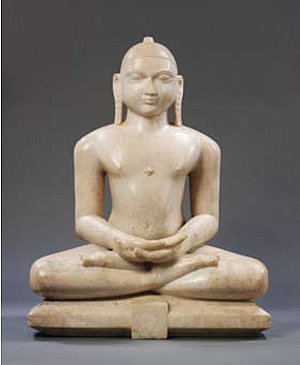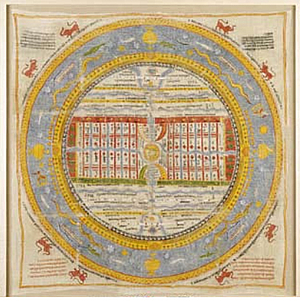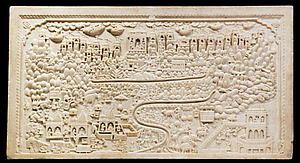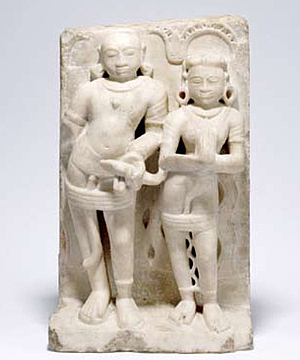
Centre of Jaina Studies Newsletter: SOAS - University of London
The Indian temple has been a focal point of artistic movement in the Indian subcontinent since the 5th century CE. It was the theme of a recent exhibition held from 4 August to 15 November 2010 at the Shanghai Museum, part of the Expo 2010 cultural programme. The exhibition, curated by Dr Michael Willis of the British Museum and titled India: The Art of the Temple, brought together items from the collections of the British Museum and the Victoria and Albert Museum in London. The exhibition was in three parts, each focusing on one of the main extant religions that originated in the Indian Subcontinent. Over 100 items were sent to Shanghai, including important Jaina artefacts from both the British Museum and the Victoria and Albert Museum. Many of the pieces were publicly displayed for the first time since they entered the museums' collections.
One of the most significant Jain pieces sent to Shanghai was a cotton cloth, or paṭa, painted with a symbolic map of Jambūdvīpa, or 'island of the rose-apple tree'. (Figure 1) According to Jain cosmology, Jambūdvīpa is the central continent of the 'middle realm' (tiryag-loka) of the Jain cosmos and it is where all mortals, including the Jinas, reside. The other realms of the Jain cosmos are the 'upper realm' (ūrdhva-loka), which is occupied by celestials and the 'lower realm' (adho-loka) which is occupied by the evil and disorderly. The importance of the continent of Jambūdvīpa is that it is the only place where people are able to obtain spiritual perfection. The textile, which measures over a meter squared, depicts the continent of Jambūdvīpa as a circular land mass surrounded by a wide sea called the Lavaṇasamudra or 'salty ocean' that is so vast it cannot be crossed.

Figure 2. Candraprabha Marble; 82.5 cm h India, Rājasthān, made in Jaipur, late 19th century Victoria and Albert Museum IM 3-1920 Image © Victoria and Albert Museum

Figure 1. A map of the central island of the middle-world, Jambūdvīpa Painting on cloth; 104 cm h India, Gujarāt, 20th century British Museum (Asia) 2002,1019.0.1 Image © British Museum
In the centre of Jambūdvīpa is Mount Meru, the most sacred of mountains, flanked by two other peaks, Uttarakuru and Devakuru. Surrounding these is the region of Videha which is divided into thirty-two provinces, shown as narrow vertical strips of land surrounded by red and green borders. Attempts made to relate this symbolic representation to the real geography of India result in Videha corresponding to the plains of north India, flanked on the north by the Himālayas and on the south by the Vindhyas and Deccan plateau. These mountain ranges are shown on the map above and below Videha from which numerous rivers flow down toward the sea. The map, which prior to becoming part of the British Museum collection was used in rituals, has not previously been on public display due to its large size and delicate nature. This paṭa most likely originated in Western India, perhaps Rajasthan, in the 20th century and would possibly have hung on the walls of a temple or shrine to aid meditation and devotion.
Another highlight of the exhibition was a sculpture of the eighth Tīrthaṅkara, Candraprabha. (Figure 2) The figure, depicted in the seated meditative posture (dhyāna mudra), was created for a Digambara shrine, which is reflected in its nakedness. Although missing the cognisance of Candraprabha, (the crescent moon), the pale stone used for the sculpture exemplifies the belief in the origin of Candraprabha's name. It is said that because his mother, a queen named Lakṣmīmatī of Candrapura, had a pregnancy wish (dohada) to drink the moon when he was still an embryo, he was born with pale skin.
Made in the early 19th century, this piece gained an important place within modern Indian history when it was selected to represent modern Jain sculpture during the 1911 Coronation Durbar in Delhi. The sculpture, installed in the King Emperors Pavilion during the Durbar, was most likely displayed to foster closer connections with the Jain community, which for centuries had been heavily involved in trade and banking in India. The presence of a Jain sculpture at the Durbar was expected to show that the British were sympathetic to Jain interests and that Jains should, as a consequence, support the British Empire.

Figure 3. Marble plaque showing the holy mountain of Sammeta Śikhara White marble; 68 cm h India, Rājasthān, made in Jaipur, 19th century Victoria and Albert Museum IS 541-1883 Image © Victoria and Albert Museum
Of special interest to the Chinese audience, for which landscapes are often the focus of the most celebrated artworks, was a nineteenth-century marble plaque showing a vista of the holy mountain of Sammeta Śikhara, or Mount Parasnāth. (Figure 3) Sammeta Śikhara is important within Jain belief as twenty of the twenty-four Jinas attained nirvāṇa on the peaks of the mountain. Because of this the mountain, also known as the Parasnāth Hill and located near the town of Madhuvan in Bihar, has become a key site of pilgrimage for the Jain community. A panel such as this acts as a substitute and focal point of devotion for those unable to make the actual journey. The panel shows the winding path that leads the pilgrims from the town of Madhuvan to the hill-shrines of the Jinas. Along the path, tents and carriages are visible, and pilgrims can be seen offering devotion at the shrines, whilst wild animals are shown in the forest.
Also sent to Shanghai was a marble sculpture of a 'donor couple'. (Figure 4) This piece, carved from cream coloured marble, shows a man holding what is perhaps an offering, and a woman with her palms held together in reverence. The sculpture has a worn inscription, the only part of which that can be deciphered is 'saṃvat 1354 varṣe kār(ttika)', i.e. CE 1297 October-November. Images of donors and votive figures are common in all Indian art, but within Jainism donors are highly celebrated for their merit-making activities and in the image-worshipping traditions separate sculptural panels were often created carrying the portraits of specific donors and inscriptions. Such imagery highlighted the wealth and power of the donors, providing a memorial of their gifts and created a permanent link between the donor portrayed and the religious site, demonstrating their religiosity and fame (kīrti).

Figure 4. Panel with a donor couple Marble, 54 cm h India, west, perhaps from the site of Śatruñjaya, dated 1354 or 1297-98 British Museum (Asia) 1956,0519.3 From the Society of Antiquaries, London Image © British Museum
The Shanghai Museum exhibition also included examples of other deities of the Jain pantheon, such as the guardian/attendant yakṣa and yakṣī couples. Such protective deities are an important and unusual feature of Jain art. The consistent association with particular Tīrthaṅkaras has caused certain protective deities to become popular with the Jain laity. One example is a beautiful eleventhcentury sculpture of Padmāvatī, a protective goddess and śāsanadevī of Pārśvanātha, the twenty-third Tīrthaṅkara. (Figure 5) She became associated with Pārśvanātha after he rescued Padmāvatī, in her previous incarnation as a snake, from being burnt alive in a sacrificial fire. This explains why Padmāvatī is shown holding a snake, with another at her feet whilst a large snake canopy rises above her head. It is clear that this sculpture represents Padmāvatī due to the small representation of Pārśvanātha above her serpent canopy. Padmāvatī's popularity with the Jain laity stems from her role as a protector from snakes and poisons, which has lead to many sculptures and paintings of the śāsanadevī being created.
Whilst these items are just some of the 19 impressive Jain artifacts sent to Shanghai, the significance of their journey should not be lost. Not only was the exhibition the first public display of many of the Jain items since they entered the museums' collections but the exhibition India: The Art of the Temple acted as an introduction for the audience to Jain art and indeed Jainism overall. From the time of its opening on 4 August 2010 until it closed on 15 November, the exhibition was visited by over 600,000 people, who were able to experience some of the most impressive Jain art from the collections of the British Museum and Victoria and Albert Museum.

Figure 5. Padmāvatī the śāsanadevī of Pārśvanātha Blueish gray sandstone; 48.2 cm h India, central, probably Mālvā region, 11th century British Museum (Asia) 1957,1021.1 Image © British Museum
Cam Sharp Jones is a SOAS alumna, MA South Asian Anthropology. She is now a freelance writer who focuses on South Asian art, and is currently researching Jain art and culture.
 Cam Sharp Jones
Cam Sharp Jones